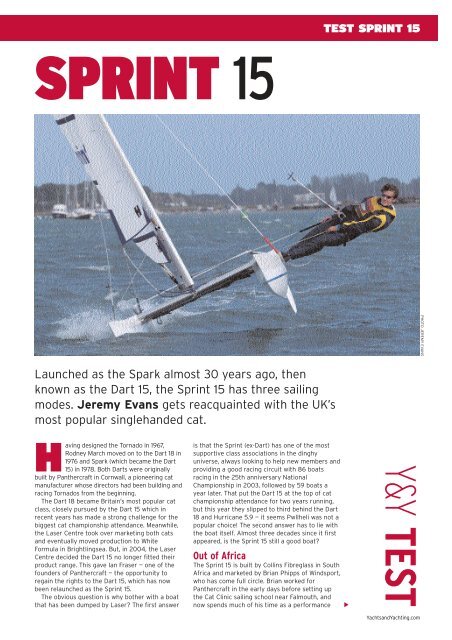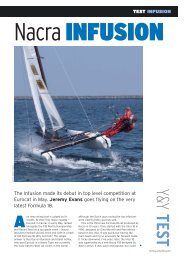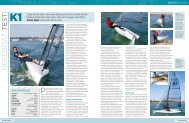Sprint 15 lyt AD
Sprint 15 lyt AD
Sprint 15 lyt AD
Create successful ePaper yourself
Turn your PDF publications into a flip-book with our unique Google optimized e-Paper software.
TEST SPRINT <strong>15</strong><br />
SPRINT <strong>15</strong><br />
PHOTO JEREMY EVANS<br />
Launched as the Spark almost 30 years ago, then<br />
known as the Dart <strong>15</strong>, the <strong>Sprint</strong> <strong>15</strong> has three sailing<br />
modes. Jeremy Evans gets reacquainted with the UK’s<br />
most popular singlehanded cat.<br />
Having designed the Tornado in 1967,<br />
Rodney March moved on to the Dart 18 in<br />
1976 and Spark (which became the Dart<br />
<strong>15</strong>) in 1978. Both Darts were originally<br />
built by Panthercraft in Cornwall, a pioneering cat<br />
manufacturer whose directors had been building and<br />
racing Tornados from the beginning.<br />
The Dart 18 became Britain’s most popular cat<br />
class, closely pursued by the Dart <strong>15</strong> which in<br />
recent years has made a strong challenge for the<br />
biggest cat championship attendance. Meanwhile,<br />
the Laser Centre took over marketing both cats<br />
and eventually moved production to White<br />
Formula in Brightlingsea. But, in 2004, the Laser<br />
Centre decided the Dart <strong>15</strong> no longer fitted their<br />
product range. This gave Ian Fraser — one of the<br />
founders of Panthercraft — the opportunity to<br />
regain the rights to the Dart <strong>15</strong>, which has now<br />
been relaunched as the <strong>Sprint</strong> <strong>15</strong>.<br />
The obvious question is why bother with a boat<br />
that has been dumped by Laser The first answer<br />
is that the <strong>Sprint</strong> (ex-Dart) has one of the most<br />
supportive class associations in the dinghy<br />
universe, always looking to help new members and<br />
providing a good racing circuit with 86 boats<br />
racing in the 25th anniversary National<br />
Championship in 2003, followed by 59 boats a<br />
year later. That put the Dart <strong>15</strong> at the top of cat<br />
championship attendance for two years running,<br />
but this year they slipped to third behind the Dart<br />
18 and Hurricane 5.9 — it seems Pwllheli was not a<br />
popular choice! The second answer has to lie with<br />
the boat itself. Almost three decades since it first<br />
appeared, is the <strong>Sprint</strong> <strong>15</strong> still a good boat<br />
Out of Africa<br />
The <strong>Sprint</strong> <strong>15</strong> is built by Collins Fibreglass in South<br />
Africa and marketed by Brian Phipps of Windsport,<br />
who has come full circle. Brian worked for<br />
Panthercraft in the early days before setting up<br />
the Cat Clinic sailing school near Falmouth, and<br />
now spends much of his time as a performance<br />
▲<br />
Y&Y TEST<br />
YachtsandYachting.com
PHOTOS JEREMY EVANS<br />
Above The <strong>Sprint</strong> <strong>15</strong> can<br />
be sailed in two-up<br />
hiking mode with main<br />
and jib — perfect for<br />
lightweight son or<br />
daughter crew.<br />
Right Older sailors tend<br />
to race the non-trapeze<br />
<strong>Sprint</strong> singlehanded<br />
under main only.<br />
YachtsandYachting.com<br />
cat coach. Clearly, he’s never lost his enthusiasm<br />
for Rodney March’s <strong>15</strong>ft cat.<br />
Bob Carter, one of the longest-serving members<br />
of the class association, brought the first <strong>Sprint</strong> <strong>15</strong><br />
‘Out of Africa’ for our test session in Chichester<br />
Harbour, where he was particularly keen to show<br />
off the multi-role capability of the boat. In essence<br />
the <strong>Sprint</strong> <strong>15</strong> is three cats in one: singlehanded<br />
hiking mode with the mainsail; two-up hiking mode<br />
with mainsail and jib; and singlehanded trapeze<br />
mode with mainsail and jib, which is called Sport<br />
<strong>15</strong>. The two non-trapeze <strong>Sprint</strong>s race boat-on-boat<br />
at all class association events, while the faster<br />
Sport has a handicap of four minutes in a 100 over<br />
the standard <strong>Sprint</strong>, plus its own national<br />
championship each season.<br />
Older sailors tend to race the non-trapeze<br />
<strong>Sprint</strong>, mainly singlehanded but with the option of<br />
taking a lightweight crew. Thanks to Hattie for<br />
stepping in as Bob’s 10-year-old crew, a perfect<br />
age to join dad (or grandad) for a spot of cat<br />
racing. Thanks also to Tom Gall who took time out<br />
from North Sails to race his favourite small boat in<br />
dynamic Sport mode. Tom is typical of the ‘<strong>15</strong><br />
family’ type of sailor, out at the front on the Sport<br />
while his dad hikes round on the standard boat,<br />
trying to maintain that 4/100 advantage.<br />
Design and updates<br />
The <strong>Sprint</strong> <strong>15</strong> may be almost three decades old, but<br />
it doesn’t appear outdated. As Tom says, ‘It’s a<br />
classic,’ and the new boat looks exciting, dynamic<br />
and considerably more stylish than many monohull<br />
dinghy classics. The only notable changes from the<br />
Dart <strong>15</strong> are new shroud and hatch covers — which<br />
were very difficult to open on this pre-production<br />
boat — plus a simpler righting line, 4mm shrouds<br />
and an easier replacement system for toestraps<br />
and tramp sliders. The ‘Out of Africa’ boat<br />
appeared clean and well built, with a slim, classic<br />
hull shape reminiscent of a scaled-down Tornado<br />
without centreboards.<br />
One potential advantage over most cats is that<br />
you don’t have to transport the <strong>Sprint</strong> <strong>15</strong> on an<br />
expensive cat trailer. Beams slot and lock into the<br />
hulls using the original Dart system, which makes<br />
it reasonably quick and easy to disassemble the<br />
boat for carrying on a roofrack with the standard<br />
two-part mast. That also means you can tow a<br />
caravan or travel by ferry without paying double<br />
the cost — useful, as two Isle of Wight clubs are<br />
<strong>Sprint</strong> and Sport <strong>15</strong> strongholds.<br />
Rigging and launching<br />
If you appreciate a boat that’s as quick as a Laser<br />
to rig, the <strong>Sprint</strong> could be for you — pull up the
TEST SPRINT <strong>15</strong><br />
mainsail, plus jib if required, attach the rudders<br />
and go. With small dimensions and relatively light<br />
weight, it’s easy for one adult to wheel around the<br />
boat park and launch. You’ve also got a very stable<br />
platform to hop on and get sorted, a simple rudder<br />
lock system and no daggerboards to worry about.<br />
In fact there’s not much to worry about at all. No<br />
boom, so you don’t get hit on the head, with the top<br />
block of the multi-purchase mainsheet just hooking<br />
onto the clew. The only other mainsail controls are<br />
downhaul, which requires a grunty pull to flatten<br />
the sail for stronger winds, and the mainsheet<br />
traveller which slides down the beam for sailing<br />
deep downwind. If you’re with a crew there’s<br />
obviously a pair of jib sheets for them to pull, and if<br />
you’re in Sport mode there’s the trapeze.<br />
Compared to a modern racing cat with square<br />
top mainsail, multiple sail controls and a kite for<br />
offwind blasting, the <strong>15</strong> rig does look distinctly oldfashioned.<br />
The mainsail is an elliptical pinhead<br />
that holds its aerofoil shape with full length<br />
battens, but no boom means there’s no foot<br />
tension apart from the pull of the mainsheet and<br />
no chance of getting a super-flat foil for strong<br />
wind control. But the great thing is that it’s simple,<br />
quite effective and in boating terms cheap to put<br />
right if things go wrong. The lack of kite doesn’t<br />
affect the <strong>15</strong>. It wasn’t designed for a kite, can’t be<br />
raced in class with a kite, but no doubt could be<br />
fitted with a shute if an owner wanted to for fun.<br />
Three in one<br />
Tom Gall gave ‘Out of Africa’ a great shakedown in<br />
Sport mode, demonstrating that it’s a lot of fun<br />
for a blast in a fresh wind. Personal experience<br />
has shown that the <strong>15</strong> is also a small cat with hull<br />
volume that is by modern standards low at the<br />
bows. Tom didn’t put a foot wrong — less<br />
experienced cat sailors will find the <strong>15</strong> offers an<br />
exciting challenge and may indulge in occasional<br />
trips down the mine.<br />
Bob demonstrated how mature sailors prefer to<br />
hike the boat, which I don’t altogether<br />
comprehend. Trapezing the Sport may require<br />
some monkey-like scrambles, but hiking up the<br />
beat has never been my definition of fun.<br />
However, Bob looks pretty relaxed in the photos<br />
and the <strong>Sprint</strong> <strong>15</strong> should be quick enough to get to<br />
the windward mark in reasonable time.<br />
Hattie had a wonderful ride as crew, and<br />
appeared to be just the right size and shape for<br />
the boat. Bob reckons the perfect age range for a<br />
crew is 10-<strong>15</strong> years, beyond which they start to get<br />
a bit big and heavy. My own experience at a Dart<br />
<strong>15</strong> open meeting confirmed that it’s a lot of fun to<br />
race the boat with a young teenage daughter, but<br />
tricky to keep up with the experienced<br />
singlehanders who make <strong>15</strong>s go very fast at the<br />
front of the fleet.<br />
One problem with a singlehanded cat is having<br />
enough leverage to get it upright after a capsize.<br />
The <strong>15</strong> is small and relatively narrow, with a sealed<br />
mast and slim, high aspect mainsail not providing<br />
the dead weight that so often holds a cat down.<br />
Bob righted ‘Out of Africa’ three times in<br />
succession and reckons that a 50kg (eight stone)<br />
helm could get the <strong>15</strong> upright without too much<br />
difficulty. We did not put this claim to the test, but<br />
suspect some experience and the right weather<br />
conditions might be required.<br />
Class and circuit<br />
The <strong>Sprint</strong> <strong>15</strong> is quick because it’s a cat and fun<br />
because it’s small. It’s quick to rig, easy to sail<br />
and will generally be forgiving if the driver gets<br />
things wrong. In cat terms, it’s cheap to buy and<br />
own, with an active second-hand market thanks<br />
to the dynamic class association. Apart from<br />
separate national championships for the <strong>Sprint</strong><br />
and Sport, the class runs both a summer and<br />
winter series at various locations where usual<br />
turnout is <strong>15</strong>-30 boats.<br />
There is also a good selection of clubs with<br />
<strong>Sprint</strong> <strong>15</strong> fleets, split between standard and Sport.<br />
Grafham Water is the biggest, followed by Instow<br />
in Devon, Gurnard and Shanklin on the Isle of<br />
Wight, Carsington in the Peak District, Beaver near<br />
Doncaster, Marconi on the Blackwater, Open<br />
Dinghy Club near Worthing, Whitstable and<br />
Seasalter on the north Kent coast, Stewartby in<br />
Bedfordshire, Thorpe Bay near Southend, Halifax<br />
▲<br />
Above The popular Sport<br />
mode, singlehanded<br />
trapezing with both main<br />
and jib.<br />
Below left The <strong>Sprint</strong> <strong>15</strong><br />
is simple to rig and<br />
launch, and manageable<br />
enough for one person to<br />
wheel around.<br />
PHOTOS JEREMY EVANS<br />
Y&Y TEST<br />
YachtsandYachting.com
ANSWER BACK<br />
from Brian Phipps<br />
and Filey in Yorkshire, Queen Mary Reservoir,<br />
Swanage in Dorset, Thornbury on the River<br />
Severn, Draycote near Rugby and Netley on the<br />
River Hamble which is starting to build a fleet.<br />
The <strong>Sprint</strong> <strong>15</strong> is not just for racing. The national<br />
championships generally incorporate three days of<br />
fun sailing and family cruising, often bolstered by<br />
multi-boat families — the current record is four<br />
<strong>Sprint</strong> <strong>15</strong>s owned by one family for mum, dad,<br />
daughter and son! Many <strong>15</strong>s are used as holiday<br />
fun boats and never race at all. If the wind doesn’t<br />
blow, it’s nice to have an exclusive seaside<br />
swimming platform! ■<br />
Thanks to Cobnor Activities centre (CAC) for providing<br />
facilities for this test. CAC runs a full programme of<br />
residential and non-residential sailing courses and activities<br />
in Chichester harbour. For more informaition visit<br />
www.cobnor.com<br />
Above The ‘Out of<br />
Africa’ boat has a slim,<br />
classic hull shape<br />
reminiscent of a scaleddown<br />
Tornado without<br />
centreboards.<br />
PHOTO JEREMY EVANS<br />
Thanks to Y&Y, Jeremy and the sailing team for<br />
giving the Collins-built <strong>Sprint</strong> <strong>15</strong> a good shakedown.<br />
Great sailing conditions and good sailors<br />
show off any boat at its best but the real value is<br />
relating the boat to the needs of potential sailors.<br />
The <strong>Sprint</strong> <strong>15</strong> has attributes no other catamaran<br />
can match, many of which Jeremy very effectively<br />
identified. Looking at the comparisons shows that<br />
the <strong>Sprint</strong> <strong>15</strong>’s attraction is far more than outright<br />
speed or plastic durability. The sail cut may look a<br />
little dated to some when compared with current<br />
thinking but the way it can be tweaked in light or<br />
strong winds using downhaul, traveller and<br />
mainsheet control, will see a <strong>Sprint</strong> <strong>15</strong> slipping<br />
along in the lightest of breeze or out in a blow<br />
when more modern catamarans might feel happier<br />
back on the shore.<br />
For a potential catamaran buyer making a list of<br />
key sailing requirements it is likely the <strong>Sprint</strong> <strong>15</strong><br />
will come out close or on top, unless you want<br />
extremes of complexity or durability. Everything is<br />
a compromise but the <strong>Sprint</strong> <strong>15</strong> is one of the best<br />
small catamarans at getting that right.<br />
The basic price of £5,500 is great value for a<br />
boat that is light enough to put on a car roof, can<br />
be sailed one or two-up, and launched<br />
singlehanded. Windsport are also offering their<br />
special ‘Out of Africa’ edition, including coloured<br />
sails, trolley and top cover, for a limited period.<br />
Product support will be via Windsport’s personal<br />
service, from a team that have the interest of the<br />
class and the sailor at heart. Demonstrations and<br />
catamaran tuition or coaching sessions will be<br />
available via Windsport or the class programme.<br />
Windsport look forward to a long association with<br />
current and future <strong>Sprint</strong> <strong>15</strong> sailors of all ages.<br />
Specification <strong>Sprint</strong> <strong>15</strong><br />
COMPARISONS… Where does the <strong>Sprint</strong> <strong>15</strong> fit in Here are some alternatives…<br />
DESIGN: Rodney March in 1978<br />
BUILDER: Collins Fibreglass, South Africa<br />
SCHRS: 1.32 una-rig, 1.37 2-up, 1.23 Sport<br />
LENGTH: 4.54m<br />
BEAM: 2.13m<br />
SAILING WEIGHT:<br />
104kg<br />
MAINSAIL:<br />
10.19sq m<br />
JIB:<br />
2.1sq m<br />
PRICE: (Out of Africa edition) £5,795<br />
CONTACT:<br />
YachtsandYachting.com<br />
Windsport International<br />
Mylor Harbour<br />
Falmouth<br />
Cornwall<br />
TR11 5UF<br />
TEL: 01326 376 191<br />
EMAIL:<br />
info@windsport.co.uk<br />
WEB:<br />
www.sprint<strong>15</strong>.com<br />
■ Shadow<br />
Superb and totally modern<br />
singlehander designed and developed<br />
by Yves Loday and Reg White.<br />
LOA: 4.8m<br />
BEAM: 2.4m<br />
SAILING WEIGHT:<br />
99kg<br />
SCHRS: 1.07<br />
SAIL AREA:<br />
Mainsail<br />
13sq m<br />
Spinnaker<br />
10sq m<br />
GUIDE PRICE: £8,194*<br />
■ Dart 16<br />
Low-cost polyethylene hulls keep the<br />
price down on this entry level cat,<br />
which also has a spinnaker option.<br />
LOA: 4.8m<br />
BEAM: 2.3m<br />
HULL WEIGHT:<br />
48kg<br />
SCHRS: 1.28<br />
SAIL AREA:<br />
Mainsail<br />
10.4sq m<br />
Jib<br />
3.16sq m<br />
GUIDE PRICE: £5,045*<br />
*Guide prices are approximate and include sails







